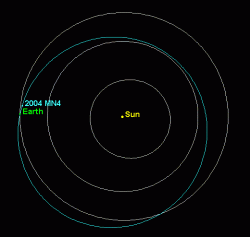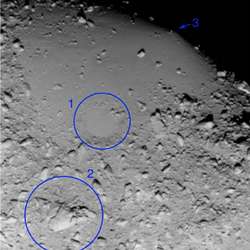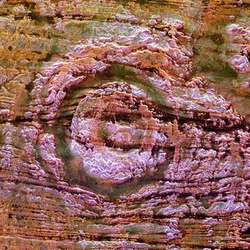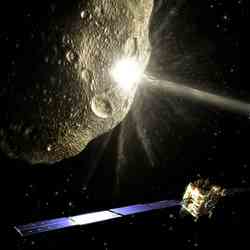 The Planetary Society is offering a $50,000 prize for the best plan to reach out an put a tracking beacon on near-Earth asteroid Apophis (AKA 2004 MN4). Apophis is approximately 400 metres across, and it’s expected to pass very close to the Earth in 2029. And on that pass, it could receive a gravitational bump to its orbit that could make it even more dangerous in 2036. With better tracking, scientists will have a much better idea if Apophis really is a risk to Earth. The competition ends August 31, 2007.
The Planetary Society is offering a $50,000 prize for the best plan to reach out an put a tracking beacon on near-Earth asteroid Apophis (AKA 2004 MN4). Apophis is approximately 400 metres across, and it’s expected to pass very close to the Earth in 2029. And on that pass, it could receive a gravitational bump to its orbit that could make it even more dangerous in 2036. With better tracking, scientists will have a much better idea if Apophis really is a risk to Earth. The competition ends August 31, 2007.
Continue reading “Tag an Asteroid, Win a Prize”
Just a Single Asteroid Strike Wiped out the Dinosaurs
Most scientists agree that a large asteroid strike 65 million years ago ended the dinosaurs’ reign on Earth. Some think that a single strike did the trick, while others think it was multiple strikes and additional stresses that pushed the dinosaurs into extinction. New evidence from researchers at the University of Missouri-Columbia supports the single impact hypothesis. They found a single layer of impact-related material in the geologic record that exactly matched marine creatures known to be contemporaries of the dinosaurs. They didn’t find any other impact evidence above or below this layer, reducing the possibility of additional impacts.
Continue reading “Just a Single Asteroid Strike Wiped out the Dinosaurs”
Detailed Look at Twin Asteroid 1999 KW4
Asteroid 1999 KW4 was first discovered by astronomers in 1999. When it got closer, in 2001, astronomers realized it wasn’t a single asteroid, but two clusters of rubble orbiting each other. It’s been classified as a Potentially Hazardous Asteroid, but astronomers have calculated a safe trajectory out for at least 1,000 years. Since it’s a binary object, astronomers are able to calculate the mass and density of the two asteroids. New observations from the Arecibo Observatory have mapped the twin objects in tremendous detail.
Continue reading “Detailed Look at Twin Asteroid 1999 KW4”
It Took More than an Asteroid to Kill the Dinosaurs
How did the dinosaurs die? It’s a question scientists have been trying to figure out since their fossils were first discovered. Most believe that it was a giant asteroid that stuck the Yucatan peninsula 65 million years ago, and ended the dinosaurs’ reign on Earth. But evidence is mounting that the asteroid strike might have just been the final killing blow. The previous 500,000 years were unpleasant too, with multiple meteor strikes, severe volcanism, and rapid climate change.
Continue reading “It Took More than an Asteroid to Kill the Dinosaurs”
The Link Between Asteroids and Meteorites
In theory, asteroids and meteorites are made of the same basic elements; it’s just that asteroids are much much bigger. But scientists had always found troubling chemical differences between the two kinds of objects. New data gathered by the Japanese spacecraft Hayabusa, which recently visited the near-Earth asteroid Itokawa, shows that there’s a good reason for the difference. It’s the long-term effect of space weathering – solar and cosmic radiation – that changes the surface of asteroids to look different from meteorites.
Continue reading “The Link Between Asteroids and Meteorites”
Fast Moving New Horizons Tracks an Asteroid
Still a decade away from its final meeting with Pluto, New Horizons tested out its instruments on a relatively nearby asteroid. The spacecraft turned its Multispectral Visible Imaging Camera (MVIC) on asteroid 2002 JF56 at a range of 1.34 to 3.36 million kilometers (about 833,000 to 2.1 million miles). Controllers were happy to see that the camera system was able to track the asteroid while the spacecraft was moving so quickly; it’ll need this capability when it reaches Pluto. Its next stop will be Jupiter, which it’s due to encounter on February 28, 2007.
Continue reading “Fast Moving New Horizons Tracks an Asteroid”
Earth’s Second Moon is About to Leave Us
In addition to the Moon, the Earth also has a collection of co-orbital satellites. These are really nothing more than asteroids briefly captured by the Earth’s gravity. Instead of orbiting the Earth, they take corkscrew paths around our planet, eventually escaping back into the Solar System. One asteroid, 2003 YN107, has been traveling with us since 1999, and now it’s about to depart, building up enough speed to escape the Earth’s gravity.
Continue reading “Earth’s Second Moon is About to Leave Us”
Science Team Determines Composition of Asteroid Itokawa

Asteroid Itokawa. Image credit: JAXA. Click to enlarge
Itokawa, a spud-shaped, near-Earth asteroid, consists mainly of the minerals olivine and pyroxene, a mineral composition similar to a class of stony meteorites that have pelted Earth in the past.
This asteroid ingredient list, published in Science, comes courtesy of Hayabusa, the spacecraft launched in 2003 by the Japanese Aerospace Exploration Agency (JAXA). The mission of Hayabusa is to bring back first-ever samples from an asteroid to better understand their role as building blocks of the solar system.
Itokawa, an elongated rocky object nearly as long as five football fields, circles the sun more than 321 million miles away from Earth. Along with a few hundred known asteroids, Itokawa’s orbit is close to Earth’s orbit and was discovered by the Lincoln Near-Earth Asteroid (LINEAR) program, which detects near-Earth asteroids and provides advance warning if any are bound for Earth. Itokawa doesn’t currently pose such a threat, but its close proximity made it a tempting scientific target.
A near-infrared spectrometer aboard Hayabusa helped identify Itokawa’s mineralogy, mostly a mixture of the rock-forming minerals olivine and pryroxene, and possibly some plagioclase and metallic iron. But to truly understand what they had, the team turned to Takahiro Hiroi, a Brown University researcher who is expert in determining the composition of asteroids and meteorites, bits of asteroids that have fallen to Earth.
Hiroi is a senior research associate in the Department of Geological Sciences at Brown and the operations manager of the University’s NASA-funded Reflectance Experiment Laboratory (RELAB). For the Hayabusa project, Hiroi obtained samples of meteorites from museums, measured them at RELAB, and compared these results with spectral data from Itokawa.
Hiroi was able to determine that the mineral composition of the surface of Itokawa was similar to that of LL chondrites, a common class of stony meteorites relatively low in metallic iron. This link helped the team place a probable source of origin for Itokawa: the inner portion of the main asteroid belt, a ring of tens of thousands of rocks orbiting the sun between Mars and Jupiter.
Using Hayabusa data, the team was also able to better describe the surface of Itokawa. Much of it is studded with boulders, although the asteroid contains a smoother area known as Muses Sea. This diversity of terrain, the team concludes, may be the result of past meteoroid impacts and space weathering, a rock-altering process due to bombardments by dust particles and solar wind.
“We’ve never had a close-up look at such a small asteroid until now,” Hiroi said. “Large asteroids such as Eros are completely covered with a thick regolith, a blanket of looser material created by space weathering. With Itokawa, we believe we have witnessed a developing stage of the formation of this regolith. And these boulders sitting on Itokawa are no different from the meteorites that have fallen on Earth. So we may be seeing an earlier stage of asteroid evolution, of a type that has touched this planet.”
NASA and JAXA funded the work.
Original Source: Brown University
Searching For Crater Chains on the Earth

Aorounga impact crater. Image credit: NASA/JPL. Click to enlarge
Comet 73P/Schwassmann Wachmann 3 is a beautiful sight in the night sky, especially now that it’s fractured into many pieces. There’s evidence for these kinds of impacts on several planets and moons in the Solar System, and astronomers watched 23 fragments of Comet Shoemaker-Levy 9 smash into Jupiter in 1993. What if a string of comet fragments like this hit the Earth? There are only a few examples of these kinds of impacts on the Earth; unfortunately, wind, rain and tectonic forces work to hide the evidence.
As the fragments of shattered comet 73P/Schwassmann Wachmann 3 glide harmlessly past Earth this month in full view of backyard telescopes, onlookers can’t help but wonder, what if a comet like that didn’t miss, but actually hit our planet?
For the answer to that question, we look to the Sahara desert.
In a remote windswept area named Aorounga, in Chad, there are three craters in a row, each about 10 km in diameter. “We believe this is a ‘crater chain’ formed by the impact of a fragmented comet or asteroid about 400 million years ago in the Late Devonian period,” explains Adriana Ocampo of NASA headquarters.
Ocampo and colleagues discovered the chain in 1996. The main crater “Aorounga South” had been known for many years?it sticks out of the sand and can be seen from airplanes and satellites. But a second and possibly third crater were buried. They lay hidden until radar onboard the space shuttle (SIR-C) penetrated the sandy ground, revealing their ragged outlines.
“Here on Earth, crater chains are rare,” says Ocampo, but they are common in other parts of the solar system.
The first crater chains were discovered by NASA’s Voyager 1 spacecraft. In 1979 when the probe flew past Jupiter’s moon Callisto, cameras recorded a line of craters, at least fifteen long, evenly spaced as if someone had strafed the moon with a Gatling gun. Eventually, eight chains were found on Callisto and three more on Ganymede.
At first the chains were a puzzle. Were they volcanic? Had an asteroid skipped along the surface of Callisto like a stone skipping across a pond?
The mystery was solved in 1993 with the discovery of Comet Shoemaker-Levy 9. SL-9 was not a single comet, but a “string of pearls,” a chain of 21 comet fragments created a year earlier when Jupiter’s gravity ripped the original comet apart. SL-9 struck back in 1994, crashing into Jupiter. Onlookers watched titanic explosions in the giant planet’s atmosphere, and it only took a little imagination to visualize the result if Jupiter had had a solid surface: a chain of craters.
Astronomers have since realized that fragmented comets and rubble-pile asteroids are commonplace. Comets fall apart rather easily; sunlight alone can shatter their fragile nuclei. Furthermore, there is mounting evidence that many seemingly solid asteroids are assemblages of boulders, dust and rock held together by feeble gravity. When these things hit, they make chains.
In 1994, researchers Jay Melosh and Ewen Whitaker announced their finding of two crater chains on the Moon. One, on the floor of the crater Davy, is spectacular–an almost perfect line of 23 pockmarks each a few miles in diameter. This proved that crater chains exist in the Earth-Moon system.
But where on Earth are they?
Earth tends to hide its craters. “Wind and rain erode them, sediments fill them in, and the tectonic recycling of Earth’s crust completely obliterates them,” says Ocampo. On the Moon, there are millions of well-preserved craters. On Earth, “so far we’ve managed to find only about 174.”
Sounds like a job for Google. Seriously. Amateur astronomer Emilio Gonzalez pioneered the technique in March 2006. “I use Google Earth,” he explains. Google Earth is a digital map of our planet made of stitched-together satellite images. You can zoom in and out, fly around and inspect the landscape in impressive detail. It’s a bit like a video game-except it is real.
Gonzalez began by calling up Kebira impact crater in Libya?the Sahara’s largest. It was so easy to see, he recalls, “I decided to look around for more.” Minutes later he was “flying” over the Libya-Chad border when another crater appeared. And then another. They both had multiple rings and a central peak, the telltale splash of a high-energy impact. “It couldn’t be this easy!” he marveled.
But it was. At least one of the craters had never been catalogued before, and both, almost incredibly, lined up with the Aorounga crater 200 km away: map. In less than 30 minutes, Gonzalez had found two good impact candidates and possibly multiplied the length of the Aorounga chain. Hours of additional searching produced no new results. “Beginner’s luck,” he laughs. (If you would like to hunt for your own craters online, Gonzalez offers these tips.)
Ocampo doubts that these new craters are related to Aorounga. “They don’t appear to be the same age.” But she can’t rule it out either.
“We need to do some fieldwork,” she says. To prove a crater is a crater-and not, say, a volcano-researchers must visit the site to look for signs of extraterrestrial impact such as “shatter cones” and other minerals forged by intense heat and pressure. This kind of geological study can also reveal the age of an impact site, marking it as part of a chain or an independent event.
Answers may have to wait. Civil war in Chad and the possibility of war between Chad and Sudan prevent scientists from mounting an expedition. Meanwhile, researchers are scrutinizing candidate chains in Missouri and Spain. Although those sites are more accessible than Chad, researchers still can’t decide if they are chains or not. It’s difficult work.
Ocampo believes it’s worth the effort. “The history of Earth is shaped by impacts,” she says. “Crater chains can tell us important things about our planet.”
And so the search goes on.
Original Source: NASA News Release
Don Quijote Will Reach Out and Impact an Asteroid

Impacts with very large asteroids are uncommon. Image credit: ESA Click to enlarge
Asteroids don’t hit the Earth often, but when they do, the results can be catastrophic. The European Space Agency is working on several approaches to minimize the chances we’ll make a close encounter with an asteroid. A new mission, called Don Quijote, will launch in 2011 and slam an impactor probe into an asteroid to see what happens. An orbiter spacecraft will remain in orbit around the asteroid and continue to study the aftereffects of the impact. There are now three European teams working on preliminary studies for the potential mission.
If a large asteroid such as the recently identified 2004 VD17 – about 500 m in diameter with a mass of nearly 1000 million tonnes – collides with the Earth it could spell disaster for much of our planet. As part of ESA’s Near-Earth Object deflecting mission Don Quijote, three teams of European industries are now carrying out studies on how to prevent this.
ESA has been addressing the problem of how to prevent large Near-Earth Objects (NEOs) from colliding with the Earth for some time. In 1996 the Council of Europe called for the Agency to take action as part of a “long-term global strategy for remedies against possible impacts”. Recommendations from other international organisations, including the UN and the Organisation for Economic Cooperation and Development (OECD), soon followed.
In response to these and other calls, ESA commissioned a number of threat evaluation and mission studies through its General Studies Programme (GSP). In July 2004 the preliminary phase was completed when a panel of experts appointed by ESA recommended giving the Don Quijote asteroid-deflecting mission concept maximum priority for implementation.
Now it is time for industry to put forward their best design solutions for the mission. Following an invitation to tender and the subsequent evaluation process, three industrial teams have been awarded a contract to carry out the mission phase-A studies. :
– a team with Alcatel Alenia Space as prime contractor includes subcontractors and consultants from across Europe and Canada; Alcatel Alenia Space developed the Huygens Titan probe and is currently working on the ExoMars mission
– a consortium led by EADS Astrium, which includes Deimos Space from Spain and consultants from several European countries, brings their experience of working on the design of many successful ESA interplanetary missions such as Rosetta, Mars and Venus Express
– a team led by QinetiQ (UK), which includes companies and partners in Sweden and Belgium, draws on their expertise in mini and micro satellites including ESA’s SMART-1 and Proba projects
This month the three teams began work and a critical milestone will take place in October when the studies will be reviewed by ESA with the support of an international panel of experts. The results of this phase will be available next year.
The risk is still small however, and may decrease even further when new observations are carried out. Still, if this or any other similar-sized object, such as 99942 Apophis, an asteroid that will come close enough to the Earth in 2029 to be visible to the naked eye, collided with our planet the energy released could be equivalent to a significant fraction of the world’s nuclear arsenal, resulting in devastation across national borders.
Luckily, impacts with very large asteroids are uncommon, although impacts with smaller asteroids are less unlikely and remote in time. In 1908 an asteroid that exploded over Siberia devastated an unpopulated forest area of more than 2000 km2; had it arrived just a few hours later, Saint Petersburg or London could have been hit instead.
Asteroids are a part of our planet’s history. As anyone visiting the Barringer Meteor Crater in Arizona, USA or aiming a small telescope at the Moon can tell, there is plenty of evidence that the Earth and its cosmic neighbourhood passed through a period of heavy asteroid bombardment. On the Earth alone the remains of more than 160 impacts have been identified, some as notorious as the Chicxulub crater located in Mexico?s Yucatan peninsula, believed to be a trace of the asteroid that caused the extinction of the dinosaurs 65 million years ago.
Collisions have shaped the history of our Solar System. Because asteroids and comets are remnants of the turbulent period in which the planets were formed, they are in fact similar to ‘time capsules’ and carry a pristine record of those early days. By studying these objects it is possible to learn more about the evolution of our Solar System as well as ‘hints’ about the origins of life on Earth.
Comet 67P/Churyumov-Gerasimenko is one of these primitive building blocks and will be visited by ESA’s Rosetta spacecraft in 2014, as a part of a very ambitious mission – the first ever to land on a comet. Rosetta will also visit two main belt asteroids (Steins and Lutetia) on its way to comet 67P/Churyumov-Gerasimenko. The mission will help us to understand if life on Earth began with the help of materials such as water and organisms brought to our planet by ‘comet seeding’.
ESA’s Science programme is already looking at future challenges, and its Cosmic Vision 2015-2025 plan has identified an asteroid surface sample return as one of the key developments needed to further our understanding of the history and composition of our Solar System.
Asteroids and comets are fascinating objects that can give or take life on a planetary scale. Experts around the world are putting all their energy and enthusiasm into deciphering the mysteries they carry within them.
With an early launch provisionally scheduled for 2011, Don Quijote will serve as a ‘technological scout’ not only to mitigate the chance of the Earth being hit by a large NEO but also for the ambitious journeys to explore our solar system that ESA will continue to embark upon. The studies now being carried out by European industry will bring the Don Quijote test mission one step nearer.
Original Source: ESA Portal
